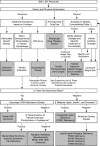Pediatric Obesity-Assessment, Treatment, and Prevention: An Endocrine Society Clinical Practice Guideline
- PMID: 28359099
- PMCID: PMC6283429
- DOI: 10.1210/jc.2016-2573
Pediatric Obesity-Assessment, Treatment, and Prevention: An Endocrine Society Clinical Practice Guideline
Abstract
Cosponsoring associations: The European Society of Endocrinology and the Pediatric Endocrine Society. This guideline was funded by the Endocrine Society.
Objective: To formulate clinical practice guidelines for the assessment, treatment, and prevention of pediatric obesity.
Participants: The participants include an Endocrine Society-appointed Task Force of 6 experts, a methodologist, and a medical writer.
Evidence: This evidence-based guideline was developed using the Grading of Recommendations, Assessment, Development, and Evaluation approach to describe the strength of recommendations and the quality of evidence. The Task Force commissioned 2 systematic reviews and used the best available evidence from other published systematic reviews and individual studies.
Consensus process: One group meeting, several conference calls, and e-mail communications enabled consensus. Endocrine Society committees and members and co-sponsoring organizations reviewed and commented on preliminary drafts of this guideline.
Conclusion: Pediatric obesity remains an ongoing serious international health concern affecting ∼17% of US children and adolescents, threatening their adult health and longevity. Pediatric obesity has its basis in genetic susceptibilities influenced by a permissive environment starting in utero and extending through childhood and adolescence. Endocrine etiologies for obesity are rare and usually are accompanied by attenuated growth patterns. Pediatric comorbidities are common and long-term health complications often result; screening for comorbidities of obesity should be applied in a hierarchal, logical manner for early identification before more serious complications result. Genetic screening for rare syndromes is indicated only in the presence of specific historical or physical features. The psychological toll of pediatric obesity on the individual and family necessitates screening for mental health issues and counseling as indicated. The prevention of pediatric obesity by promoting healthful diet, activity, and environment should be a primary goal, as achieving effective, long-lasting results with lifestyle modification once obesity occurs is difficult. Although some behavioral and pharmacotherapy studies report modest success, additional research into accessible and effective methods for preventing and treating pediatric obesity is needed. The use of weight loss medications during childhood and adolescence should be restricted to clinical trials. Increasing evidence demonstrates the effectiveness of bariatric surgery in the most seriously affected mature teenagers who have failed lifestyle modification, but the use of surgery requires experienced teams with resources for long-term follow-up. Adolescents undergoing lifestyle therapy, medication regimens, or bariatric surgery for obesity will need cohesive planning to help them effectively transition to adult care, with continued necessary monitoring, support, and intervention. Transition programs for obesity are an uncharted area requiring further research for efficacy. Despite a significant increase in research on pediatric obesity since the initial publication of these guidelines 8 years ago, further study is needed of the genetic and biological factors that increase the risk of weight gain and influence the response to therapeutic interventions. Also needed are more studies to better understand the genetic and biological factors that cause an obese individual to manifest one comorbidity vs another or to be free of comorbidities. Furthermore, continued investigation into the most effective methods of preventing and treating obesity and into methods for changing environmental and economic factors that will lead to worldwide cultural changes in diet and activity should be priorities. Particular attention to determining ways to effect systemic changes in food environments and total daily mobility, as well as methods for sustaining healthy body mass index changes, is of importance.
Copyright © 2017 by the Endocrine Society
Figures



Comment in
-
Letter to the Editor: "Pediatric Obesity-Assessment, Treatment, and Prevention: An Endocrine Society Clinical Practice Guideline".J Clin Endocrinol Metab. 2017 Jun 1;102(6):2121-2122. doi: 10.1210/jc.2017-00351. J Clin Endocrinol Metab. 2017. PMID: 28586452 Free PMC article. No abstract available.
-
Response to Letter: "Pediatric Obesity-Assessment, Treatment, and Prevention: An Endocrine Society Clinical Practice Guideline".J Clin Endocrinol Metab. 2017 Jun 1;102(6):2123-2124. doi: 10.1210/jc.2017-00561. J Clin Endocrinol Metab. 2017. PMID: 28586453 Free PMC article. No abstract available.
References
-
- Daniels SR, Hassink SG; Committee on Nutrition . The role of the pediatrician in primary prevention of obesity. Pediatrics. 2015;136:e275–e292. - PubMed
-
- Atkins D, Best D, Briss PA, Eccles M, Falck-Ytter Y, Flottorp S, Guyatt GH, Harbour RT, Haugh MC, Henry D, Hill S, Jaeschke R, Leng G, Liberati A, Magrini N, Mason J, Middleton P, Mrukowicz J, O’Connell D, Oxman AD, Phillips B, Schunemann HJ, Edejer T, Varonen H, Vist GE, Williams JW Jr, Zaza S. Grading quality of evidence and strength of recommendations. BMJ. 2004;328:1490. - PMC - PubMed
-
- Swiglo BA, Murad MH, Schunemann HJ, Kunz R, Vigersky RA, Guyatt GH, Montori VM. A case for clarity, consistency, and helpfulness: state-of-the-art clinical practice guidelines in endocrinology using the grading of recommendations, assessment, development, and evaluation system. J Clin Endocrinol Metab. 2008;93:666–673. - PubMed
-
- Guyatt GH, Schunemann HJ, Djulbegovic B, Akl EA. Guideline panels should not GRADE good practice statements. J Clin Epidemiol. 2015;68:597–600. - PubMed
-
- Rajjo T, Mohammed K, Alsawas M, Ahmed AT, Farah W, Asi N, Almasri J, Prokop LJ, Murad MH. Treatment of pediatric obesity: an umbrella systematic review. J Clin Endocrinol Metab. 2017;102:763–775. - PubMed
Publication types
MeSH terms
Substances
Grants and funding
LinkOut - more resources
Full Text Sources
Other Literature Sources
Medical

